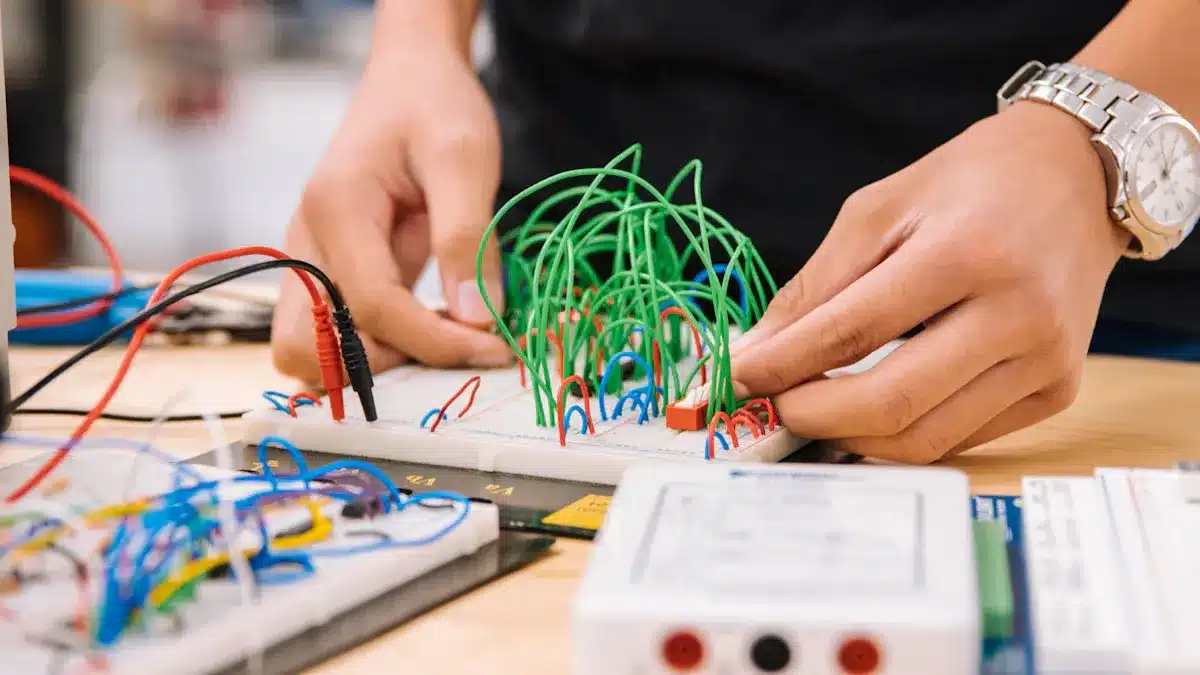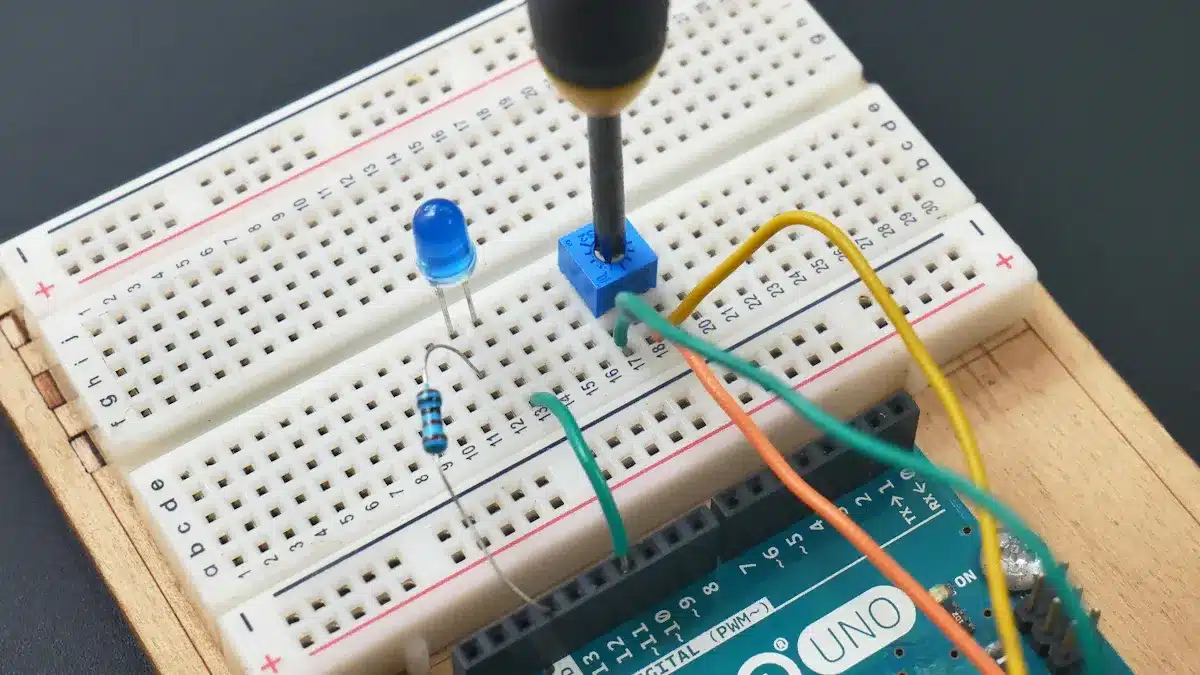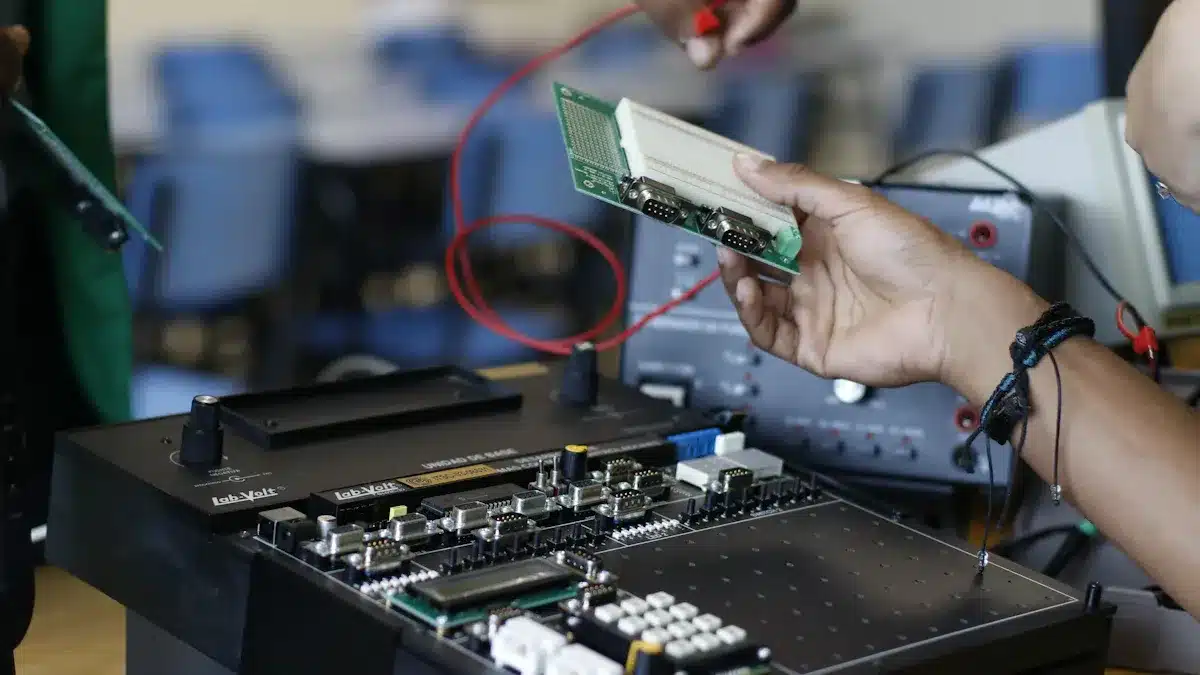
Potentiometers and pot variable resistors are important parts of electronics. You see them in things like volume knobs or light dimmers. A potentiometer has three terminals and controls voltage in a circuit, while a pot variable resistor has two terminals and changes resistance directly.
Knowing the difference between them helps you choose the right one. These tools let you adjust circuits with accuracy and ease.
Key Takeaways
Potentiometers have three pins and control voltage in circuits. They are useful for changing volume or screen brightness.
Variable resistors have two pins and adjust resistance directly. They help control current in things like motors or lights.
Use a potentiometer for accurate voltage changes. Pick a variable resistor for easier tasks needing current adjustment.
Both parts are important in electronics, making devices like speakers, lights, and sensors work better.
When choosing parts, think about resistance range, power limits, and the environment to get the best results.
Potentiometer: Definition and Functionality

What is a Potentiometer?
A potentiometer is an electronic part with three terminals. It changes voltage in a circuit. It works as both a variable resistor and a voltage divider. This lets you control electrical signals accurately. Its design includes a resistive material and a sliding wiper. The wiper moves to adjust the output. Common materials used are carbon, metal, or special plastics. These materials make it strong and reliable.
Feature | Description |
|---|---|
Functionality | Works as a variable resistor and voltage divider. |
Structure | Has a resistive path and a sliding wiper; three pins. |
Material | Made of carbon, metal, or conductive plastics for strength. |
Adjustment Mechanism | Resistance changes when the wiper slides along the resistive path. |
Applications | Found in audio devices, lights, and other circuits for precise control. |
How a Potentiometer Works
A potentiometer works by moving the wiper along the resistive path. This movement changes the resistance between its terminals. That adjusts the voltage output. It has three pins: two fixed ones and one for the wiper. One pin connects to power, and another to ground. The wiper pin gives an adjustable voltage. This design makes it great for controlling signals in circuits.
Key Points:
Pin 1 connects to power.
Pin 3 connects to ground.
Pin 2 (wiper) gives the adjustable voltage.
The voltage output depends on where the wiper is positioned. It divides the input voltage into parts. This simple design is why potentiometers are popular in electronics.
Common Applications of Potentiometers
Potentiometers are used in many devices. They adjust volume in audio systems. They control brightness in lighting systems. In gaming controllers, they help with precise movements. As gadgets get smaller and smarter, potentiometers are needed more.
For example, a 10kΩ potentiometer can change resistance from 0Ω to 10kΩ. This makes it useful in many situations. These parts are key in electronics, improving how devices work and feel.
Tip: When choosing between a potentiometer and a variable resistor, remember: potentiometers are better for voltage control, while variable resistors focus on resistance changes.
Variable Resistor: Definition and Functionality
What is a Variable Resistor?
A variable resistor changes how much resistance is in a circuit. Unlike a potentiometer, it usually has two terminals, but some have three. It helps control current, protect devices, or adjust circuit settings.
There are different types, like linear and logarithmic track resistors. Linear ones change resistance evenly, while logarithmic ones change it at different speeds. For example, a 5.6kΩ linear resistor gives steady resistance, and a 2MΩ logarithmic resistor changes resistance unevenly.
How a Variable Resistor Works
A variable resistor works by changing resistance in a circuit. Turning or sliding its control changes the resistive path. This adjusts the current flow, keeping devices safe and working well.
You’ll see them in devices that need current control. They can adjust motor speed, dim lights, or fine-tune radios. They also help in sensors for current and temperature changes.
Key Features:
Stops damage by limiting too much current.
Controls motor speed and dims lights.
Adjusts settings in radios and communication tools.
Common Applications of Variable Resistors
Variable resistors are used in many devices. They dim lights, control volume, and adjust motor speeds. They also work in sensors for light, heat, or humidity.
Application | Description |
|---|---|
Changes how bright a lamp is. | |
Volume Controller | Adjusts sound levels in audio devices. |
Motor Speed Control | Changes how fast a motor runs. |
Sensing Devices | Used in tools that detect light, heat, or moisture. |
These parts make devices safer and more efficient. Whether testing loads or controlling current, variable resistors offer precise adjustments.
Potentiometer vs Variable Resistor: Key Differences

Terminal Configuration and Design
The way the terminals are set up is a big difference between a potentiometer and a variable resistor. A potentiometer has three terminals: two fixed ones at the ends and one movable one called the wiper. The wiper slides on the resistive material to change the voltage output. A variable resistor, also called a rheostat, usually has two terminals. These terminals connect directly to the resistive part, letting you change resistance without using a wiper.
Here’s a simple comparison of their terminal setups:
Feature | Potentiometer | Variable Resistor (Rheostat) |
|---|---|---|
Terminal Setup | Two terminals (two ends) | |
Function | Can work as a voltage divider or variable resistor | Mainly works as a variable resistor |
Terminal Use | Wiper connects to outer terminals for variable resistance | Two terminals connect directly for resistance |
Application | Used for voltage control tasks | Used for resistance control tasks |
Unused Terminal Effect | Circuit stays connected if wiper loses contact | No effect, as it only has two terminals |
The three-terminal design of a potentiometer makes it more flexible. It’s great for tasks needing voltage control. The simpler two-terminal design of a variable resistor works well for adjusting resistance directly.
Functionality and Purpose
These components work differently and serve different purposes. A potentiometer changes voltage by moving its wiper along the resistive path. This makes it useful for things like dimming lights or adjusting sound levels. A variable resistor changes resistance to control current in a circuit. This is helpful for tasks like changing motor speed or fine-tuning electronics.
Here’s a quick look at their functions and uses:
Feature | Potentiometer | Variable Resistor |
|---|---|---|
Function | Controls current by changing resistance | |
Purpose | Used for dimming lights, adjusting volume | Used for motor speed and circuit tuning |
Application | Common in audio and lighting control | Useful for managing current flow |
A potentiometer can act as both a voltage divider and a variable resistor. This makes it better for circuits needing precise voltage control. A variable resistor is best for tasks focused on current control.
Adjustment Range and Mechanisms
How these components adjust settings is another difference. A potentiometer uses a wiper sliding on a resistive track to change voltage smoothly. This gives it a wide adjustment range, making it good for fine-tuning signals. A variable resistor changes resistance by rotating or sliding its control. This method is simpler but less precise than a potentiometer.
The adjustment range of a potentiometer depends on the wiper’s position. For example, a 10kΩ potentiometer can adjust resistance from 0Ω to 10kΩ. This wide range makes it useful for many tasks. A variable resistor’s range is limited to its resistive value. For instance, a 5kΩ variable resistor adjusts resistance only within that range.
Tip: Use a potentiometer for projects needing precise voltage control. For simpler tasks like current adjustment, a variable resistor is easier to use.
Both components have pros and cons. Potentiometers offer more precision and flexibility but are harder to use. Variable resistors are simpler and tougher but less versatile.
Typical Use Cases
When building electronics, potentiometers and variable resistors are very useful. They have special functions that help in many projects. Let’s look at how they can improve your designs.
Potentiometer Use Cases
Potentiometers are great for controlling voltage accurately. You’ll see them in devices where adjusting signals is important. Here are some examples:
Audio Systems: Adjust sound levels in speakers or headphones with potentiometers. Turning the knob changes voltage, making the sound louder or softer.
Lighting Controls: Use potentiometers in dimmer switches to change brightness. Sliding or turning the control lets you set the perfect light level.
Gaming Controllers: Joysticks use potentiometers to sense movement. They turn physical motion into signals for smooth gameplay.
Instrumentation: Lab tools use potentiometers to fine-tune settings. This ensures accurate results during experiments.
Tip: For projects needing signal adjustments, choose a potentiometer. Its ability to divide voltage makes it reliable and versatile.
Variable Resistor Use Cases
Variable resistors, also called rheostats, are best for adjusting resistance directly. They are simple and durable, making them great for controlling current. Here are some examples:
Motor Speed Control: Change motor speeds by adjusting current with variable resistors. They’re used in fans, mixers, and other motorized devices.
Lamp Dimmers: Like potentiometers, variable resistors can dim lights. But they focus on changing resistance instead of dividing voltage.
Testing Circuits: Use variable resistors to test circuits under different loads. This helps find problems before finishing your design.
Sensors: Some variable resistors work in sensors to detect temperature, light, or humidity changes. For example, thermistors and photoresistors adjust resistance based on the environment.
Note: While potentiometers are more precise, variable resistors are easier to use for direct current control.
Choosing the Right Component
Pick a potentiometer if you need to adjust voltage. Choose a variable resistor for controlling current.
Component | Best Use Case | Example Applications |
|---|---|---|
Potentiometer | Voltage control | Audio systems, lighting, gaming devices |
Variable Resistor | Current adjustment | Motor speed control, sensors, testing |
Knowing these use cases helps you pick the right part for your project. Whether it’s a dimmer switch or motor controller, understanding these components ensures success.
Similarities Between Potentiometers and Variable Resistors
Shared Characteristics
Potentiometers and variable resistors have similar uses in circuits. Both let you change electrical properties, like voltage or current. They are useful for making devices work better. Each has a resistive path and a moving part for adjustments. You can find them in devices like speakers, lights, and sensors.
Type | Description | Applications |
|---|---|---|
Potentiometers | Adjusted with a knob, having three terminals and a slider. | |
Variable Resistors | Use a sliding part to change resistance, like wire-wound resistors. | Also found in audio systems and sensors. |
These tools make circuits more flexible and efficient. Whether adjusting sound or motor speed, they improve how devices function.
Materials and Construction
Potentiometers and variable resistors are made from strong materials for durability. Potentiometers use carbon, cermet, or wire for their resistive paths. Variable resistors, like rheostats, use nichrome wire on a ceramic base for strength. Trimmers, a type of potentiometer, have screws for fine adjustments.
Type of Resistor | Description | Construction Materials | Characteristics |
|---|---|---|---|
Potentiometers | Carbon, cermet, or wire materials | Adjustable resistance, used as voltage dividers. | |
Rheostats | Two or three-terminal device for current control. | Nichrome wire on ceramic base | Adjustable resistance, used for current control. |
Trimmers | Potentiometers with fine-tuning screws. | Carbon, cermet, or wire materials | Adjustable resistance for precise settings. |
These materials make both components tough and reliable. They can handle wear and last a long time in different devices.
Role in Circuit Design
Potentiometers and variable resistors are important in circuit design. Potentiometers divide voltage, letting you adjust it precisely. For example, a 10kΩ potentiometer can change resistance from 0Ω to 10kΩ. Variable resistors control current directly, which is great for motors or speakers.
Common Uses:
Potentiometers adjust volume, brightness, and power levels.
Variable resistors manage functions in radios, TVs, and other gadgets.
Both parts make circuits work better by allowing adjustments. Whether you’re building a dimmer or motor controller, these tools help you control your circuit easily.
How to Choose Between a Potentiometer and a Variable Resistor
Factors to Think About
Picking between a potentiometer and a variable resistor depends on your needs. Look at what your circuit requires and where the component will be used. Here are some things to keep in mind:
Resistance Range and Resolution: Make sure the part fits your circuit’s resistance needs. For detailed control, use a potentiometer with a wide range. Variable resistors are simpler for direct resistance changes.
Power Handling: Check the power rating of the part. It should handle more power than expected to avoid overheating or damage.
Size and Mounting Style: Pick a size and mounting type that works for your project. Potentiometers are small and fit audio devices, while variable resistors may need more space.
Environmental Conditions: Think about temperature and humidity. These can affect how the part works, especially outdoors or in tough settings.
Electrical Features: Look at accuracy and temperature effects. Potentiometers are better for tasks needing precise control.
Durability and Reliability: Choose strong parts to lower repair and replacement costs.
Tip: Use potentiometers for tasks like adjusting volume or screen brightness. Variable resistors are better for controlling power in high-current projects.
Real-Life Examples of Choosing Components
Seeing real examples can help you pick the right part for your project. Here are some situations:
Audio Systems: To change sound levels, use a potentiometer. It gives exact control over volume, making it popular in speakers and amplifiers.
Lighting Controls: Both potentiometers and variable resistors can dim lights. Potentiometers give smoother control, while variable resistors are easier to use.
Motor Speed Control: Variable resistors are great for controlling current directly, like adjusting motor speeds in fans or mixers.
Testing Circuits: Variable resistors are helpful for testing circuits under different conditions. They let you try out changes without altering the design permanently.
Gaming Controllers: Potentiometers in joysticks turn movement into signals. This gives accurate control during games.
Application | Best Component | Why It’s Recommended |
|---|---|---|
Audio Systems | Potentiometer | Precise control for sound levels. |
Lighting Controls | Potentiometer | Smooth brightness adjustments. |
Motor Speed Control | Variable Resistor | Direct current control for motors. |
Testing Circuits | Variable Resistor | Flexible resistance changes. |
Gaming Controllers | Potentiometer | Accurate movement-to-signal conversion. |
Note: Always match the part’s specs to your project’s needs for the best results.
Beginner Tips
If you’re new to electronics, picking and using potentiometers or variable resistors might feel tricky. Follow these tips to make it easier:
Learn the Basics: Understand how potentiometers and variable resistors work. Potentiometers adjust voltage, while variable resistors change current.
Check Environmental Needs: Pick parts that can handle the temperature and humidity of your project.
Mount Properly: Attach parts securely to avoid loose connections. Don’t tighten too much, as it can break the part.
Avoid Mistakes: Don’t go over the power limit of a part. Wire it correctly to stop short circuits or problems.
Handle High Power Carefully: For high-power projects, use parts with higher ratings and think about heat protection.
Inspect Often: Look for damage or loose connections. Regular checks keep parts working longer.
Use Good Connections: Pick quality terminals and connectors for better electrical flow.
Tip: Start with easy projects like changing resistance in a simple circuit. This helps you learn how these parts work before trying harder designs.
Potentiometers and variable resistors are important in electronics. Potentiometers change voltage, while variable resistors adjust resistance accurately. They are used in audio systems, lights, and motors. Knowing how they differ helps you pick the right one. Learning their uses improves your circuit designs and makes them better.
Tip: Look at real-world examples to learn more and design smarter circuits.
FAQ
What is the main difference between a potentiometer and a variable resistor?
A potentiometer changes voltage, while a variable resistor adjusts resistance. Potentiometers have three pins and act as voltage dividers. Variable resistors, with two pins, control current directly. For example, potentiometers adjust sound in audio devices, while variable resistors manage current flow.
Can you use a potentiometer as a variable resistor?
Yes, a potentiometer can work as a variable resistor. Use only two pins to adjust resistance instead of dividing voltage. For example, in audio circuits, this setup helps control current to speakers or other parts.
Why are potentiometers common in audio systems?
Potentiometers give precise voltage control, perfect for adjusting sound. In audio systems, they work as volume knobs, smoothly changing loudness. Their accuracy and flexibility make them important for audio devices.
How do you choose the right potentiometer for an audio project?
Check the resistance range, power rating, and type of adjustment. Linear potentiometers are good for steady changes, while logarithmic ones suit volume control. Match the potentiometer to your circuit for the best results.
Are variable resistors used in audio devices?
Yes, variable resistors are used in audio devices. They adjust current to parts like amplifiers or speakers. For example, they fine-tune power to ensure clear and balanced sound in audio systems.
See Also
Key Differences Between Active And Passive Electronic Parts
An Overview Of PCBA Coating Types And Fundamentals
Essential PCBA Components And Their Primary Functions Explained
Essential Insights On PCBA Prototypes And Their Applications